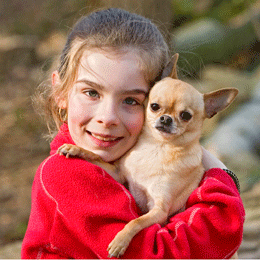Dog Aggression: Training your children
By Daniel Stevens and Martin Olliver
To ensure that your children will be safe with dogs – yours and others – they need training too. The children I mean. You will need to teach your children these important rules:
 No tug of war or “contest” games.
No tug of war or “contest” games.
Certain games encourage and elevate a dog’s aggression responses because they trigger their “prey instincts”.
Tug of war, in particular, encourages a dog to assert its strength and dominance by way of a contest. These games are a bad idea for kids.
It may look cute when puppies thrash a stuffed toy, jerking their head from side to side, but this is a carry-over from when wolves had to snap the spine of their protesting prey. It’s not the state of mind you want to promote.
Don’t push a playful or jumping dog.
When you push (or pull) a dog they are hardwired to respond with an equal and opposite force. Translation: they will push/pull back.
So, to stop a dog jumping, a child needs to stay calm enough to avoid encouraging the behavior. Unfortunately high-pitched giggling, squealing, or even crying is music to an excited dog’s oversensitive ears. You’ll need to work with your whole family on having commands to interrupt this behavior, such as a low-pitched “Down” or “Ouch” followed by ignoring or physically separating child from dog.
Don’t touch tail or paws.
Young children seem to target tails – they’re easy to reach, grab, pull – and they get a reaction. But because dogs can’t see what’s behind them, if something pulls their tail they will respond quickly and firmly, often with their mouth open and primed.
Dogs are touchy about their paws too. Back in their pack-hunting days, their paws were their main means of survival. Naturally they’re protective of them. So, kids – hands off.
Pat gently – or scratch
Most dogs don’t like being patted on the head. They much prefer being scratched gently on the chest - right between the front legs - or to have their back scratched right above the root of the tail.
No ‘attack’ commands or threats
Attack commands like “Sic him” should not be part of your child’s vocabulary. The intention might be all fun and games but a dog can’t tell the difference. Equally, children must not be allowed to rush towards or corner a dog - this behavior can arouse dangerous reactions.
No reprimands
To avoid confusing your dog, particularly a young dog, its best that children don’t do the ‘telling off’. That’s best left to the ‘trainer’. A child may know the right words but the trainer’s body language will be more consistent, hence more effective.
After you’re done with basic training for your children, there are a few tips to give them for dealing with other people’s dogs, which is where a lot of dog aggression problems start:
Ask first
When you want to pet a strange dog, always ask the owner first if you can say “hello” to their dog.
Pet ‘underhand’
When greeting a new dog it’s always best to pet “underhand” - making hand contact under the dog’s jaw. This is a non-threatening contact that allows the dog to see your hand (and what it’s doing) at every point.
Tied up = keep away
If a dog is tied up on its own, however friendly it may look, never approach or pet it. Dogs that are tied up can easily feel “cornered” by an approaching child or group of children and will act defensively.
Dogs also feel challenged by a head-on approach and by direct eye contact. This kind of confrontation invites trouble and is best avoided.
Start with a few simple rules
Kids love to teach other kids what they know. You’ll find that if you start them with a few simple rules, the knowledge will spread and lead to a safer relationship between kids and canines.
All the best,
![]()
Daniel Stevens and the Secrets to Dog Training Team
"Secrets to Dog Training - STOP Dog Behavior Problems!"
http://www.kingdomofpets.com/dogobediencetraining/
P.S. Forward this Newsletter to a friend
If you have a friend you think may be interested in training their dog or solving a particular dog behavior problem, please feel free to forward them this Newsletter.
P.P.S. Remember – you have full access to our Members’ Forum
Because you are a Member of ‘Secrets to Dog Training’ you have full access to our Members’ Forum. If you have a dog behavior question or a related problem, you are most welcome to bring it to the Forum. Post a detailed description for our trainers and fellow Members to read. Within 1-4 working days you will see recommendations on how to solve it once and for all.
If you haven’t already registered for the Forum, you can do this from the Members’ Area: http://www.kingdomofpets.com/dogobediencetraining/members/ or you can go straight there by clicking here – http://www.kingdomofpets.com/dog/forum/